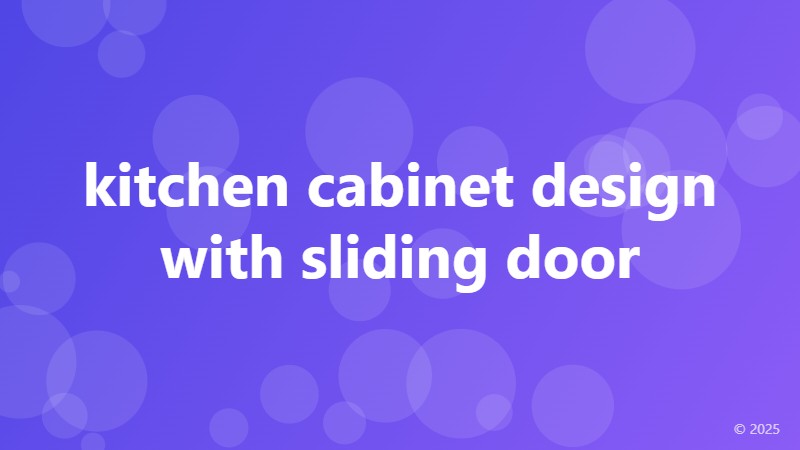kitchen cabinet design with sliding door

Optimizing Your Kitchen Space with Sliding Door Cabinets
When it comes to kitchen design, one of the most crucial elements to consider is the cabinetry. Not only do cabinets provide storage and organization, but they also play a significant role in the overall aesthetic of the room. With the increasing popularity of modern and minimalist designs, kitchen cabinet design with sliding doors has become a sought-after feature in many homes. In this article, we'll delve into the benefits and design considerations of incorporating sliding door cabinets into your kitchen space.
The Advantages of Sliding Door Cabinets
Sliding door cabinets offer a range of benefits that make them an attractive option for homeowners. Firstly, they provide easy access to the contents of the cabinet, eliminating the need to open and close traditional doors. This feature is particularly useful in kitchens where space is limited, as it allows for a more streamlined workflow. Additionally, sliding doors can help to reduce clutter and create a sense of openness, making the kitchen feel larger than it actually is.
Another significant advantage of sliding door cabinets is their ability to conceal contents from view. This can be particularly useful in kitchens where appliances and cookware are often left out, creating a cluttered and chaotic appearance. By incorporating sliding doors, homeowners can keep their kitchen essentials hidden from view, creating a more organized and peaceful space.
Design Considerations for Sliding Door Cabinets
When designing a kitchen with sliding door cabinets, there are several factors to consider. Firstly, the type of sliding door mechanism used can greatly impact the overall functionality of the cabinet. There are several options available, including soft-close mechanisms, push-to-open systems, and handle-free designs. Homeowners should consider their personal preferences and the overall style of their kitchen when selecting a sliding door mechanism.
Another crucial design consideration is the material and finish of the cabinets themselves. Sliding door cabinets can be crafted from a range of materials, including wood, MDF, and laminate. The finish can also vary, with popular options including matte, gloss, and textured. Homeowners should choose a material and finish that complements the overall aesthetic of their kitchen, while also providing durability and ease of maintenance.
Incorporating Sliding Door Cabinets into Your Kitchen Design
When incorporating sliding door cabinets into your kitchen design, it's essential to consider the overall layout and workflow of the space. Homeowners should assess their storage needs and identify areas where sliding door cabinets can be used to maximum effect. This may include installing sliding door cabinets near cooking stations, sinks, or appliance garages to create a more efficient workflow.
Additionally, homeowners should consider the style and design of their sliding door cabinets in relation to the overall aesthetic of their kitchen. For example, modern kitchens may benefit from sleek, handle-free sliding doors, while traditional kitchens may suit more ornate, decorative designs.
By incorporating sliding door cabinets into your kitchen design, you can create a more efficient, organized, and visually appealing space. With their ability to conceal contents, provide easy access, and enhance the overall aesthetic of the kitchen, sliding door cabinets are an attractive feature for any homeowner looking to optimize their kitchen space.